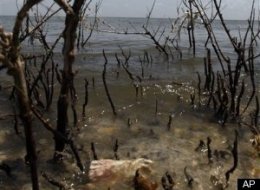Oil Stopped For Now, Long Way Still To Go
The new containment cap has been closed off to the point where little or no oil is escaping. This is the first time in 86 days that oil has not been leaking from BP’s damaged well. While this is an exciting development the well will be monitored for some time before the procedure can be called successful.
 |
 |
If the capping procedure does prove successful it will obviously be an important step in drawing this disaster to a conclusion but there will still be a long way to go. The relief well remains the only solution for permanently “plugging” the well and there will still be an unknown extremely large quantity of dispersed oil in the Gulf environments with unknown long term effects. Unified command has also indicated that BP will likely go back to collecting oil from the well while the relief well finishes drilling, though hopefully without any oil leaking into the Gulf of Mexico.
“We’re encouraged by this development, but this isn’t over,” said Admiral Thad Allen, National Incident Commander. “Over the next several hours we will continue to collect data and work with the federal science team to analyze this information and perform additional seismic mapping runs in the hopes of gaining a better understanding on the condition of the well bore and options for temporary shut in of the well during a hurricane. It remains likely that we will return to the containment process using this new stacking cap connected to the risers to attempt to collect up to 80,000 barrels of oil per day until the relief well is completed.”
Louisiana Environmental Action Network and Lower Mississippi Riverkeeper will continue to work on this, our nations biggest oil spill disaster, until we are certain that this oil is no longer impacting our natural resources or our communities and BP has made every effort to fix all of the damage that they have caused.
- Approximately 1.82 million gallons of total dispersant have been applied
- 1.07 million on the surface
- 749,000 sub-sea
- 348 controlled burns have been conducted
- Just on July 14 there was approximately 572 miles of Gulf Coast shoreline oiled, this does not include cumulative impacts.
- 328 miles in Louisiana
- 108 miles in Mississippi
- 67 miles in Alabama
- 69 miles in Florida
- Unified Command had estimated that between 1.5 million and 2.5 million gallons oil were leaking every day
- That would mean that between 93.5 million and 184.3 million gallons of oil have spilled into the Gulf to date
- However Unified Command expects to collect up to 80000 barrels of oil per day from the well wich amounts to 3.36 million gallons per day.
:}
More Monday
:}









![[Article Image]](http://s3.amazonaws.com/the_mark/wide_photos/1494/original.jpg?1273693702)






